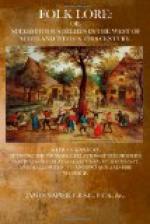The following information concerning the government, &c., of fairyland, is taken from Aytoun:—The queen of fairyland was a kind of feudatory sovereign under Satan, to whom she was obliged to pay kave, or tithe in kind; and, as her own fairy subjects strongly objected to transfer their allegiance, the quota was usually made up in children who had been stolen before the rite of baptism had been administered to them. This belief was at one time universal throughout all Scotland, and was still prevalent at the beginning of this century. Charms were quite commonly employed to defend houses from the inroads of the fairies before the infants were baptised; but even baptism did not always protect the baby from being stolen. During the period of infancy, the mother required to be ever watchful; but the risks were especially great before baptism. It is difficult to define exactly the power which the queen of elfland had, for besides carrying off Thomas the Rhymer, she was supposed to have carried off no less a personage than James IV. from the field of Flodden, and to have detained him in her enchanted country. There was also a king of elfland. From the accounts extracted from or volunteered by witches, &c., preserved to us in justiciary and presbyterial records, he appears to have been a peaceable, luxurious, indolent personage, who entrusted the whole business of his kingdom, including the recruiting department, to his wife. We get a glimpse of both their majesties in the confessions of Isabella Gowdie, in Aulderne, a parish in Nairnshire, who was indicted for witchcraft in 1662. She said—“I was in Downie Hills, and got meat there from the queen of the fairies, more than I could eat. The queen is brawly clothed in white linen, and in white and brown cloth; and the king is a braw man, well-favoured, and broad-faced. There were plenty of elf bulls rowting and skoyling up and down, and affrighted me.”




